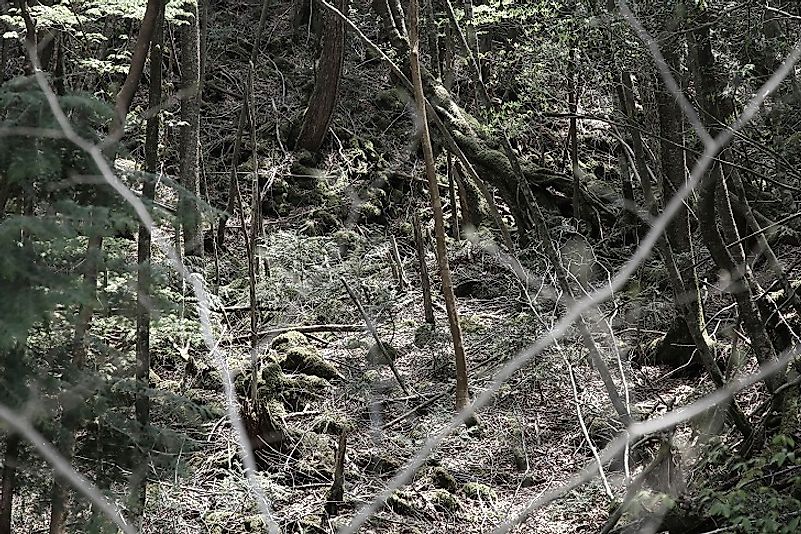Did You Know The Mysterious Aokigahara Forest Is Also Known As The Suicide Forest?

5. Geology, Geography, and Climate
The Aokigahara, also known as the Suicide Forest of Japan or the “Sea of Trees”, is an extremely dense, mysterious forest occupying an area of 35 square kilometers at the northwest base of Mount Fuji in Japan. The forest floor, consisting primarily of volcanic rocks, was formed as a result of a massive eruption from Mount Fuji in the year 864. As a result of the eruption, lava flows from the mountain formed a cavern-riddled coating at the base of the mountain. Vegetation soon started growing in the rich volcanic soil of the region that led to the formation of the highly dense Aokigahara forest of the present day.
4. Mythological Significance
The Aokigahara forest is associated with the angry, terrifying spirits of Japanese mythology known as “yūrei" . It is also believed that the forest is haunted by the spirits of the dead. Some legends relate the forest to the custom of ubasute, wherein the weak or inconvenient family members, such as old-aged men and women or those who are not very successful in their endeavors, are discarded during stressful times like famines and droughts by their families in remote forests like the Aokigahara. There they were left to die by cold exposure, starvation or dehydration.
3. Modern Suicide Hot-Spot and Media Portrayal
The Aokigahara forest has a dark past and present alike, and is regarded as the most popular suicide site in Japan, and the third most popular one in the entire world. Through the year 1988, there were about 30 annual suicides committed in the forest in modern times. The number of suicides gradually increased thereafter, reaching 78 in 2002 and 105 in 2003. Over 200 people attempted suicide in the forest in 2010, of which 54 managed to be successful in their attempts. The high rates of suicide in this forest is a cause of extreme concern to the Japanese authorities, demanding the immediate need for measures to stop such incidences. Hanging and drug overdose are the two most commonly adopted suicide methods in this forest. Local legends associate the suicides to the haunting of the forest by ghosts and spirits of the dead. The haunted reputation of the Aokigahara forest has thus inspired the creation of several movies, ghost series, poems, writings, and music based on the forest. Famous horror movies like 2010's Forest of the Living Dead, the 2013 film Grave Halloween, the 2015 The Sea of Trees, and the 2016 The Forest are each largely based on the Aokigahara Forest. The tales of Aokigahara’s suicides have also been popularized by Seichō Matsumoto’s novel Kuroi Jukai , The Three by Sarah Lotz, and The Suicide Forest by Jeremy Bates,. Reports of the suicides committed at Aokigahara have also been frequently published by Japanese and international news agencies, magazines, and other forms of media publication.
2. Native Habitats and Biodiversity
The Aokigahara forest is covered by thick, dense vegetation comprising of both evergreen, coniferous trees like Japanese cypress and hemlock firs, and broad-leaf trees like Japanese andromeda, longstalk hollies, Fuji cherries, and maples. The thin layers of topsoil in these woodlands forces the trees to stretch their roots along the forest floor, lending them a crawly-creepy appearance. The thick undergrowth in the forest also makes it highly impenetrable, especially in its interior parts. There is not much data regarding the wildlife of the Aokigahara forest. Bats are known to inhabit the caves of the forests, and numerous rodent species, insects, and a variety of birds, including the Great Spotted woodpecker and Japanese Bush warbler, are also spotted in the forest.
1. Suicide Prevention
The high rate of suicides in Aokigahara have worried the concerned authorities and citizens of the region for decades. Several measures have been adopted by the Japanese government to discourage suicide attempts in the forest. Signboards with hotline contact numbers have been set up at various entry points in the forest, requesting people to stop thinking of suicide and instead go about seeking professional help. Police in the region have created a team of watchmen and volunteer local citizens to watch out for any suspected suicidal persons among the tourists visiting the forest. Despite these measures, it has been difficult to stop the suicides in the forest, although in 2011 some hope could be found in a report that indicated a 9.4% drop in suicide rates in Aokigahara. What is worse is that, unlike other forests of the world where tourists trail along the forest in search of bird and animal life, in Aokigahara the search is often for the remains and belongings of the dead human beings who have taken their lives there. Visitors are also strictly recommended to follow only the designated trails, though many tend to disobey these rules, infiltrating the other, wilder parts of the forest, leaving behind a trail of marking tape to identify their path, which in turn also litters the forest floor. There is also the possibility that the forest might be completely destroyed if Mount Fuji erupts in the near future.











